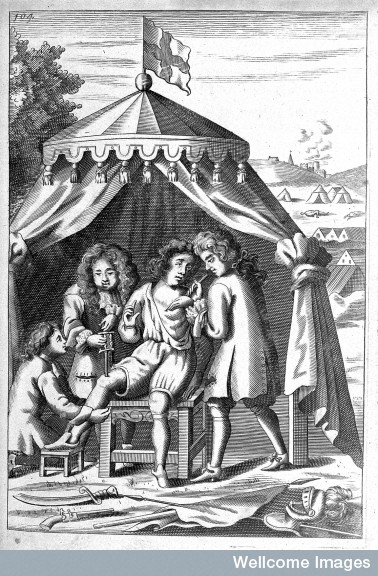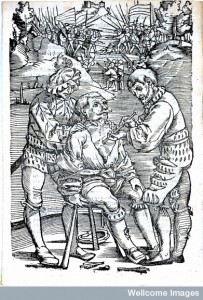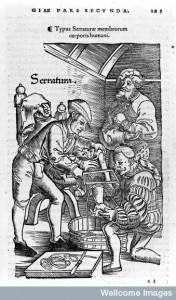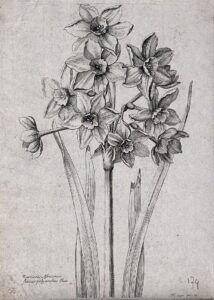
In my new research project I have been reading a lot of surgical treatises. Many popular accounts of early modern surgery focus on the idea that before the advent of anaesthesia and antiseptics the majority of surgical patients experienced exquisite torture, particularly in something like an amputation, and subsequently died from shock or infection. While true in some cases, Mary Lindemann has argued this rather bleak view of surgical practice is not entirely substantiated by the available evidence.1 She emphasises that many surgeons knowing these risks and dangers did not undertake surgical interventions lightly, and they almost never interfered with the cavity of the chest and abdomen.2 Lindemann also points out that many surgeons had acquired substantial amounts of theoretical knowledge and hands-on training.3 Indeed in the 17th century many surgeons produced written treatises to demonstrate that they possessed the theoretical medical knowledge physicians claimed as their own.

Credit: Wellcome Library, London.
In many cases surgeons acquired this hands-on knowledge on the battlefield. During the late fifteenth and early sixteenth centuries new weapons, particularly firearms, were introduced that required developments in battlefield surgery.
This battlefield knowledge is evident in many of the treatises produced by surgeons in the 16th and 17th centuries. The preface to Richard Wiseman’s treatise on wounds declared ‘I do pretend to have spent my time in Armies, Navies, and Cities, not in Universities‘.4 Ambrose Paré’s treatise on the same topic also revealed his background in military medicine: The Method of Curing Wounds made by gun-shot also by arrows and darts.
In his book on curing wounds Wiseman revealed that it was not only soldiers who were endangered by these new weapons. He included one story of an unfortunate bystander shot through the jaw at close range:
‘at our entring into Worcester, when the King came out of Scotland with an Army of that valiant People, a Townsman was shot. A Pistol fired by the Cheek, shot him through his lower Jaw and Tongue, and out by the contrary Cheek’.5
The first surgeon to undertake the cure of this injury believed that it had gangrened because of its black colour and so did not engage in the appropriate treatment. Conversely Wiseman, well versed in military medicine, knew that the ‘Wound was burnt by the flame, the very powder sticking in some parts of the Cheek’ and cured the injury.6 Wiseman, in this case, noted that for those who did not have experience gained in war gunshot wounds could pose a particular challenge, ‘It is this ugly aspect that puts the inconsiderate Chirurgeon out of his Method, and so makes Gun-shot more difficult to cure’.7 Wiseman continued in his treatise to explain how gunshot wounds had severe consequences including haemorrhaging and, if the bullet wasn’t properly extracted, inflammation. Numerous surgical treatises discussed the difficulties of curing gunshot wounds, including John Browne’s A Compleat discourse of wounds which included illustrations of surgeons in action on the battlefield.

Credit: Wellcome Library, London.
Although not a new operation, these texts also suggest that gunshot wound patients were likely to face the terror of amputation. John Moyle’s Abstractum Chirurgiae Marinae, Or An abstract of Sea Chirurgery, explained the need for naval surgeons to be decisive and confident even in the face of the ‘sad schreeking’ of the patient:
‘By this time I’le suppose the fight is be|gun, and your Ship is ingaged, and wounded men begin to be brought down: And first one, who to save his Life, must have his Limbs amputated. You see part of the Limb carried away by the Shot; as the Hand from the Arm, the Foot from the Leg, or else the Bones so shattered, that should you leave it on, there were no hopes of healing it, nor of saving the mans life. This indicates amputation, and it is speedily to be done, for ’tis no time now for you to pause upon it; your main design is to save the mans life’.8

Credit: Wellcome Library, London.
Guns and new artillery weapons were not the only hazard to health for those serving in the military. Wounds could also be caused by swords, daggers and (the newer) bayonets. Raymund Minderer’s Dutch treatise, translated into English, explained that wounds of all kinds, including those caused by bullets, affected a ‘very great number of men’.9 Thus learning to staunch blood was one of the most important elements of a surgeon’s training. Minderer offered numerous remedies to stop blood loss including the following,
‘Among the chief Astringents, is Frog-spawn; which therefore you are, when `tis in season, to make good provision of, for the whole year … This Spawn stauncheth bleeding, with a good bandage.’10
There were also much more (perhaps) mundane dangers. Minderer cautioned that because of the need to sleep outside and their irregular diet soldiers were likely to develop fevers, agues and bubos.11 Poor diet was also linked to other unsavoury medical problems ‘In Wars and Camps, Blood and other Fluxes [diarrhoea] are very frequent, caused by an irregular and ill dyet’.12 Thankfully this could be cured with oak leaves, or pear rind, and mace boiled in wine or wit crayfish boiled in vinegar, with the scales beaten to a powder, taken in red wine or broth.13
The life of a soldier as presented in surgical treatises appears to have frequently involved illness, disease and injury. Yet military, and although not explored particularly here naval, engagements not only caused great suffering and pain but advanced medical practice and physicians and surgeons fought to find new ways to save their patients.
For a more in depth and comprehensive look at the innovations of battlefield surgery and the use of boiled puppies to cure gun shot wounds head on over to Samantha Sandassie’s Panacea blog.
______________________
1. Mary Lindmann, Medicine and Society in early modern Europe (Cambridge, 2010) ,p. 266.
2. Ibid, p. 266.
3. Ibid.
4.Richard Wiseman, A Treatise of Wounds (London, 1672).
5. Ibid, p. 3.
6. Ibid. p. 3-4.
7. Ibid, p. 4.
8. John Moyle, Abstractum chirurgiae marinae., or, An abstract of sea chirurgery: designed for the use of such chirurgeons who desire to serve at sea (London, 1686), pp. 25, 23.
9. Raymund Minderer, Medicina militaris, or, A body of military medicines experimented (London, 1674), p. 109.
10. Ibid, pp. 120-1
11, pp.18-9.
12. Ibid, pp. 74-5.
13. Ibid, p. 76.





Thank you for this interesting article. You touch on a neat (and true) thesis that our default view of historical surgery is quite incomplete if it stops at some of the US Civil War’s surgeons. If you carry your analyses of surgical history further, you will find that Galen ruined everything (kidding….sorta) as did the RC Church, which could be pretty flip-floppy about what surgeons and physicians were “allowed” to do and more, what they weren’t allowed to do/who they weren’t allowed to study or train with. The surgeons of the Islamic Golden Era were doing some amazingly advanced surgery and as you so neatly noted, intra-operative pain, post-op infection and death weren’t assumed by-products. They often used methods, instruments, materials and various anesthetic concoctions that were lost or suppressed for nearly a millennium in the West. I would urge you to go all the way back to the Smith Papyrus that is/was a treatise for Egyptian Military Surgeons…3500 years ago…to see how recently we caught up to that!
Thank you for such an interesting comment. Yes there is so much more to discover about pre-modern surgery than just death and pain!
Following his hero Hippocrates, Galen limited what physicians should do. I don’t recall him limiting what surgeons should do, though I can’t claim to have read all of his vast surviving corpus. Consider all the Roman surgical tools found by archaeologists.
As for the Church, the relevant canon law limited what priests were allowed to do, not what physicians and surgeons should avoid.
Thank you for these clarifications. My Galen comment was a bad stretch at humor. My Church comment was less so, but you wrote nearly word for word what James Walsh wrote in his text “Old Time Makers of Medicine…” (Chapter X). I do have a background, albeit 30 years old, of Christian and specifically RC Theology and role in science. It was schizoid at best for a significant part of the past two millennia. If one happened to be a particularly powerful, well positioned, well known and intelligent Priest then there would be more opportunity for things like Arab medical texts and even Muslim faculty to effect change. (I am referencing the late 12th thru 14th centuries by the way) Fortunately, the early schools such as at Bologna and Salerno benefited from this but in time also suffered from changes in levels of religious tolerance. In fact, it appears that a good example of the schizoid doctrinal behavior can be seen at places like Bologna where human anatomy was studied with the knowledge of the clergy (and perhaps BY the clergy??). Fast forward a couple hundred years and many places were back to sneaking bodies thru the back door late at night. I would appreciate your impressions on these issues as well as on what I THINK I observe in my studies: that the physician:surgeon dichotomy was, relatively speaking, a later construct, given than many early practitioners, especially from the Arab schools, appear to have not built professional walls between the two. Thanks and again I apologize for my inaccuracies. I don’t mean to mislead people.
Thank you Kenneth, no need to apologise at all. I’m very happy to receive everyone’s thoughts an ideas. I’m sure no one was suggesting that you were misleading people. If that is the case I will go back through and moderate the comments again.
Best Jennifer
The canon law distinction referred to priests. There was specific reference to them wandering off to study medicine. I may misremember, but I don’t think it referred to monks, practising in the monastery, or to deacons (Linacre was one, as I recall), and least of all to friars. Dominicans and Franciscans, and their debates about natural philosophy, dominated the University of Paris.
The main point to recall is that the clergy were forbidden from the shedding of blood. One does find some Crusader bishops, but they were aristocratic oddities. Perhaps not ordained as priests. It will be recalled that the early modern Inquisitions did not execute the condemned. They “relaxed” them to the civil power.
It may well be doubted that priests did not act as physicians. Plenty can be found, although this varies according to time and place. Acting as surgeons was another matter.
Really appreciate your work, as I am exploring via family his and herstory this period for a novel – and adore the work of Captain Culpepper with his altruistic medical service and military service for New Model Army. He must have treated many soldiers for the above and himself returned home with wounds – not just with herbs?
Thank you Julie, glad it has been helpful Culpeper is one of my favourite medical authors to read, but as an apothecary he has taken a back seat in my research recently. I’m sure I will find an excuse to go back to him soon though. Your book sounds fascinating
I presume this refers to Nicholas Culpeper, which surprises me. The only military service of which I know is as a foot soldier in the Battle of Newbury, where he was seriously wounded and so surely unable to attend to the wounded, even had he the relevant skills. Do you have a source that says otherwise? I would be interested to know.
wow people have to still learn, we still dont know all we think we know ,the brain is 75% unused, the body has yet to be discovered.